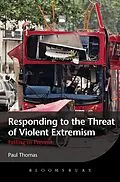This book is available as open access through the Bloomsbury Open Access programme and is available on www.bloomsburycollections.com.
How should we understand home-grown terrorism like the 7/7 London bombings? This is a classic monograph focusing on recent British attempts to 'prevent violent extremism', their problems and limitations, and what lessons this can offer for more effective policy approaches in future. Paul Thomas's extensive research suggests that the Prevent policy approaches, and the wider CONTEST counter-terrorism strategy, have been misguided and ineffective, further alienating British Muslim communities instead of supporting longer-term integration. He argues that new, cohesion-based approaches encouraging greater trust and integration across all communities represent the best defence against terrorism.
Autorentext
Paul Thomas is a Senior Lecturer in Youth and Community Work at the School of Education and Professional Development, University of Huddersfield. Previously, Paul was Youth Campaigns Officer at the Commission for Racial Equality in the north of England, and worked for a national voluntary sector youth work organisation. His 2011 book Youth, Multiculturalism and Community Cohesion drew on research from Oldham, Greater Manchester to analyse government policy approaches to ethnic cohesion and integration.
Inhalt
Contents
Acknowledgements
Preface
Glossary
Introduction: A new threat of violent extremism?
The Policy response of Prevent
The purpose of this Book
The Structure of the Book
Issues of Terminology
1. The Threat of Violent Extremism
Introduction: 'Terrorism'?
7/7: Home-grown suicide bombers
Radical Islam: the 'single narrative'
A reaction to British Foreign Policy?
A Foreign Hand?
Ethnic Segregation, Poverty and Marginalisation?
Radicalisation: Mosques, 'preachers of hate' and recruiters?
Group Dynamics
Conclusion: No easy answers
2. Community Cohesion: A changed policy context
Introduction: The changed policy context of Community Cohesion
The 2001 Riots and their aftermath
The emergence of Community Cohesion
Community Cohesion in practice
Refusing Brutishness?
Problematic Muslim Identity?
A Minority of lslamist extremists
3.Preventing Violent Extremism
Introduction: States responding to terror
A lethargic response? Pre 7/7 developments
'Preventing Extremism Together'
'Preventing Violent Extremism'
Preventing Violent Extremism in practice
Prevent under Pressure
Coalition Government: A new approach?
The Revised Prevent Strategy
Conclusion: Prevent - flawed and friendless?
4. British Muslims: A Suspect Community?
Introduction: Muslims under the spotlight
A monocultural contradiction to Community Cohesion?
Clumsy 'Social Engineering'
Learning from the experience of anti-racist education
Disinterest in far-right extremism
Conclusion: Some Communities are suspect?
5. Confusion on the Ground: Prevent in operation
Introduction: Orders from above
Local Authorities and Prevent
Local Variations
Not all bad news?
Professionals in the spotlight?
Summing up: Local Authorities in a bind?
Extremists on Campus?
Prisons and Young Offenders
Conclusion: Local Complexity
6. Spooks?
Introduction: Education or Surveillance?
CONTEST and the growth of the security state
RICU: Massaging the message?
'Spooked': Allegations and responses
Channel: A way forward?
Conclusion: Perception is everything?
